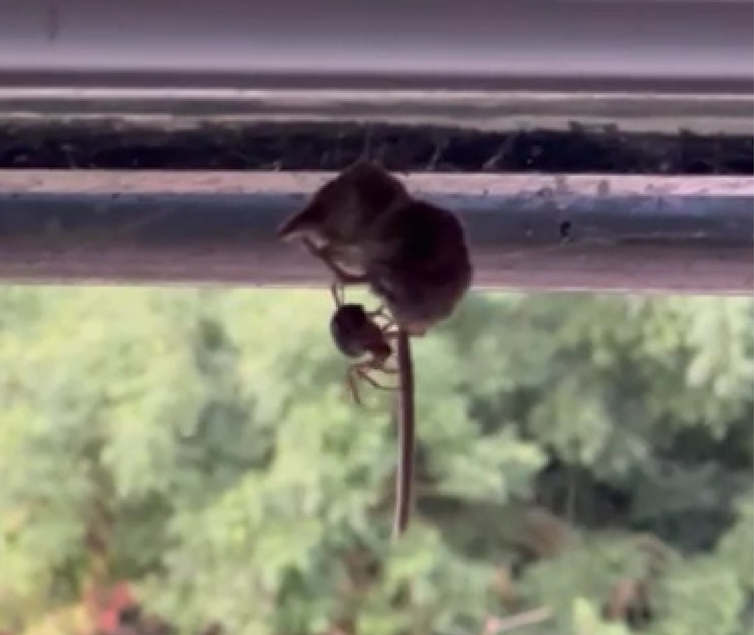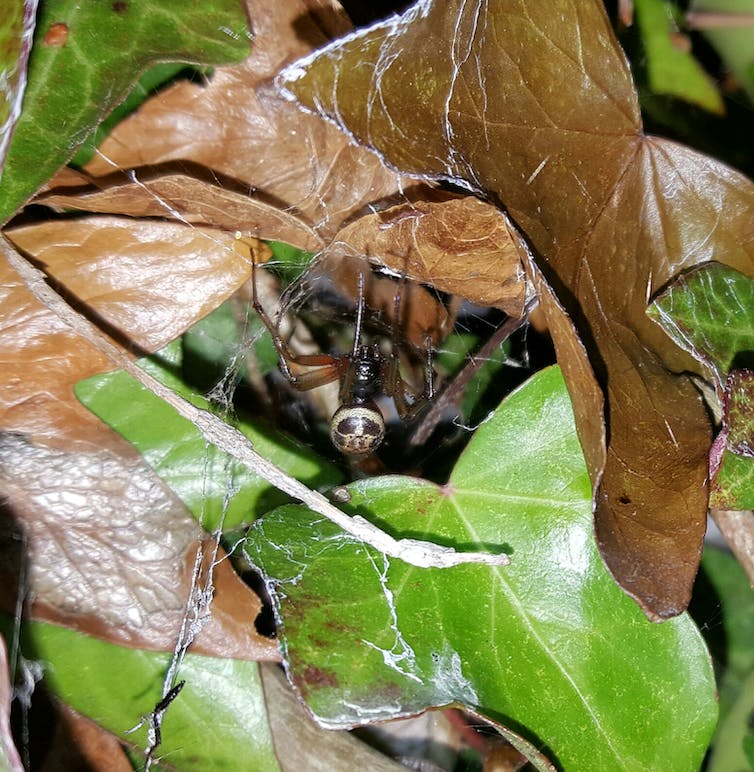The small and unassuming _Steatoda nobilis_. JorgeOrtiz_1976/Shutterstock
Over the final twenty years, an uninvited visitor has made an look in and round houses all through western Europe, together with Britain and Ireland, in addition to west Asia and the Pacific coast of North and South America.
It is small and inconspicuous, but nothing appears to cease its enlargement. From its native habitat within the nooks and crannies of caldera rocks within the highlands of Madeira and the Canary Islands, to feeding on shrews, bats and lizards within the suburbs of London and Dublin, the noble false widow spider (Steatoda nobilis) is a menace to ecosystems that you just’d in all probability overlook.
The noble false widow spider was first described by a taxonomist in 1875. Four years later the Reverend Pickard-Cambridge, a eager arachnologist, recognized a younger feminine on the south-west coast of England. In 1929, the writer and explorer William Syer Bristowe prompt that Steatoda nobilis could have been imported often from the Canary Islands in shipments of bananas.
In 2000, populations of noble false widows had been noticed in a slim space extending from Bournemouth to Southampton and Portsmouth. In 2005, they had been seen in London and Birmingham. By 2017, experiences of noble false widows had been coming from as far north as Glasgow, Edinburgh and the Orkney Islands.
Meanwhile, most of western Europe, from Portugal to northern Germany, was reporting sightings. Further east, the species was found in Turkey and Iran, whereas within the west, populations had been reported in California, Ecuador and Chile.
Despite the pace with which this spider has unfold, it has but to be formally recognised as an invasive species. Scientists should first assess the influence it has wherever it’s discovered exterior of its native vary. Following a collection of allegedly extreme spider bites within the UK and in Ireland in 2015, we on the University of Galway Venom Systems Lab started investigating.
We have since printed 13 research on the noble false widow. Our newest analysis paperwork one consuming a pygmy shrew (Sorex minutus), a protected species in Britain. This is a exceptional feat as pygmy shrews are roughly ten occasions bigger than noble false widows.
This is the primary time a spider of this sort has been seen consuming a shrew and the third documented case of 1 preying on small vertebrates, suggesting that this species usually preys on animals with backbones.

An grownup feminine noble false widow with its catch of the day – a pygmy shrew.
Dawn Sturgess, Author offered
Alien species are labeled as invasive after they reproduce and unfold past their unique web site of introduction to wreck ecosystems, human well being or the financial system. By consuming and outcompeting native species, noble false widows match the outline of an invasive species.
The noble false widow is just not a visually spectacular spider. It has a darkish, bulbous stomach bearing a light-weight brown hexagon that resembles a cranium and is roughly the scale of a 50p coin. It produces small, messy-looking webs.
When disturbed, this spider both retreats in its conceal or drops on the ground and clumsily runs for shelter. Sometimes it performs useless to keep away from being eaten. So why is it so profitable at invading new territories?
A talented (however unassuming) predator
Noble false widows outbreed their native rivals wherever they set up. This species can face up to a variety of climates and stays energetic in the course of the winter when many spiders native to Ireland and Britain decelerate. A examine in Ireland confirmed that females can lay a sack containing as much as 200 eggs each three to 4 weeks between April and September. Many native spiders lay just one to a few egg sacks a yr.

Noble false widows are prolific breeders.
John Dunbar, Author offered
Noble false widow spiders are shut cousins of “true” black widows and share roughly the identical arsenal of poisons of their venom. This features a group of neurotoxins referred to as latrotoxins which might be notably deadly to small animals with backbones.
These proteins bind to nerve endings and disrupt the messages they ship, inflicting muscular tissues and organs to overlook indicators from the mind which might result in paralysis and dying. Those who’ve been bitten by noble false widows can testify to how painful a chew might be, typically requiring medical consideration.
Their venom, which is as much as 125-times stronger than the enormous home spider (Eratigena atrica), has proved instrumental of their unfold, as they will usually flip native spiders into their subsequent meal.
The noble false widow can usually eat no matter’s accessible, together with woodlice, flies, centipedes, wasps and bees. But most placing is their capacity to prey on animals considerably bigger than themselves: lizards, bats and shrews have all been recorded as a part of their food regimen.
To accomplish such feats, false widows set silk strings loaded like springs hooked up to surfaces. When a prey brushes towards these threads, it triggers the booby entice and the animal is lifted off the bottom. The spider can then launch different threads and hoist the prey with distinctive ease utilizing its silk threads like a pulley system.
Once the prey is immobilised with silk, it paralyses them with a venomous chew. The spider expels digestive enzymes into it and sucks again the broth of softened flesh and digestive juices.
A byproduct of globalisation
Albeit fascinating, the noble false widow may harm ecosystems by displacing native spiders and preying on animals that by no means advanced to keep away from or defend themselves towards them. As such, they need to be handled like every other invasive species.
In the US between 1960 and 2020, organic invasions had been estimated to price roughly US$1.22 trillion (£1.02 trillion).
Acclimatisation societies within the nineteenth and twentieth centuries launched rabbits in Australia, possums in New Zealand and European starlings on 4 continents, all with devastating ecological penalties. These voluntary associations did so within the hope that these non-native species would adapt to their new environments.
Acclimatisation societies are lengthy gone, however the fixed motion of individuals and commodities has elevated the chance of organic invasions within the twenty first century. The phenomenal unfold of the noble false widow is a byproduct of this means of globalisation.
We now must study to reside alongside them – and do our greatest to observe their toll on native wildlife.
![]()
John Dunbar is a recipient of the Irish Research Council Government of Ireland Postdoctoral Fellowship GOIPD/2021/358.
Michel Dugon ne travaille pas, ne conseille pas, ne possède pas de elements, ne reçoit pas de fonds d'une organisation qui pourrait tirer revenue de cet article, et n'a déclaré aucune autre affiliation que son organisme de recherche.
